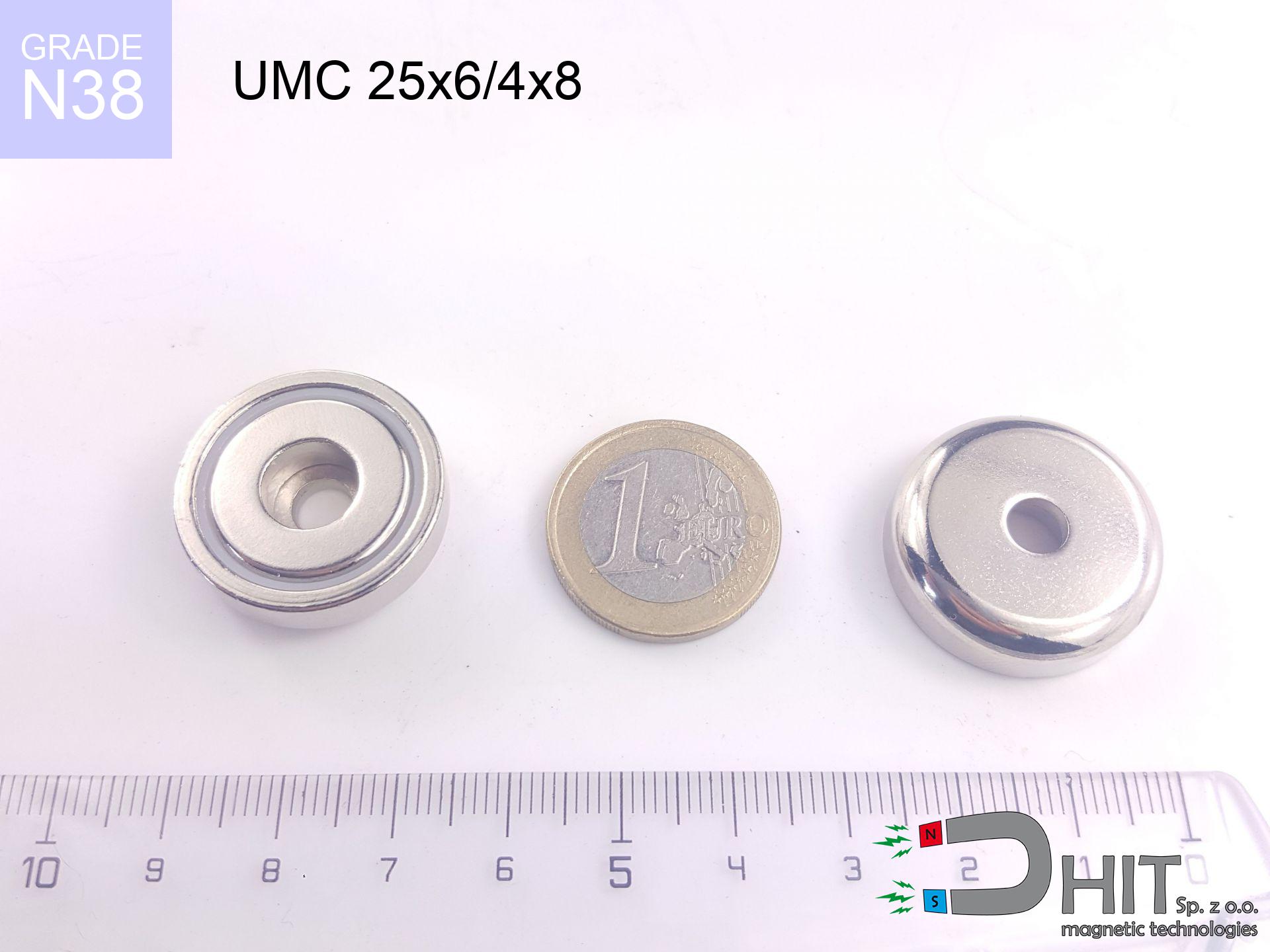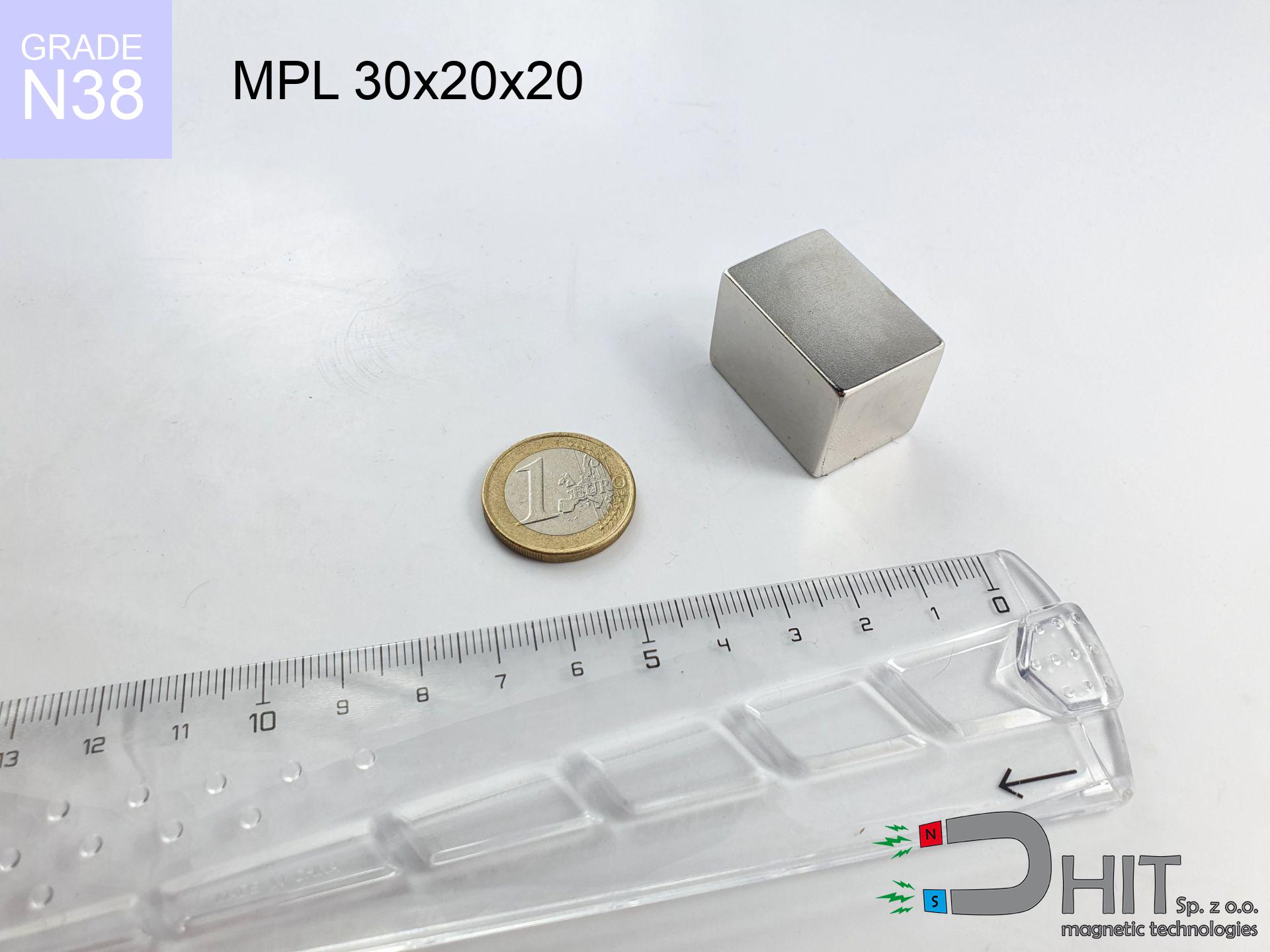UMH 16x5x32 [M4] / N38 - magnetic holder with hook
magnetic holder with hook
Catalog no 310424
GTIN/EAN: 5906301814535
Diameter Ø
16 mm [±1 mm]
Height
32 mm [±1 mm]
Height
5 mm [±1 mm]
Weight
12 g
Magnetization Direction
↑ axial
Load capacity
7.50 kg / 73.55 N
Coating
[NiCuNi] Nickel
4.88 ZŁ with VAT / pcs + price for transport
3.97 ZŁ net + 23% VAT / pcs
bulk discounts:
Need more?
Pick up the phone and ask
+48 888 99 98 98
alternatively send us a note by means of
form
the contact section.
Specifications along with appearance of magnetic components can be estimated with our
magnetic mass calculator.
Orders placed before 14:00 will be shipped the same business day.
Technical - UMH 16x5x32 [M4] / N38 - magnetic holder with hook
Specification / characteristics - UMH 16x5x32 [M4] / N38 - magnetic holder with hook
| properties | values |
|---|---|
| Cat. no. | 310424 |
| GTIN/EAN | 5906301814535 |
| Production/Distribution | Dhit sp. z o.o. |
| Country of origin | Poland / China / Germany |
| Customs code | 85059029 |
| Diameter Ø | 16 mm [±1 mm] |
| Height | 32 mm [±1 mm] |
| Height | 5 mm [±1 mm] |
| Weight | 12 g |
| Magnetization Direction | ↑ axial |
| Load capacity ~ ? | 7.50 kg / 73.55 N |
| Coating | [NiCuNi] Nickel |
| Manufacturing Tolerance | ±1 mm |
Magnetic properties of material N38
| properties | values | units |
|---|---|---|
| remenance Br [min. - max.] ? | 12.2-12.6 | kGs |
| remenance Br [min. - max.] ? | 1220-1260 | mT |
| coercivity bHc ? | 10.8-11.5 | kOe |
| coercivity bHc ? | 860-915 | kA/m |
| actual internal force iHc | ≥ 12 | kOe |
| actual internal force iHc | ≥ 955 | kA/m |
| energy density [min. - max.] ? | 36-38 | BH max MGOe |
| energy density [min. - max.] ? | 287-303 | BH max KJ/m |
| max. temperature ? | ≤ 80 | °C |
Physical properties of sintered neodymium magnets Nd2Fe14B at 20°C
| properties | values | units |
|---|---|---|
| Vickers hardness | ≥550 | Hv |
| Density | ≥7.4 | g/cm3 |
| Curie Temperature TC | 312 - 380 | °C |
| Curie Temperature TF | 593 - 716 | °F |
| Specific resistance | 150 | μΩ⋅cm |
| Bending strength | 250 | MPa |
| Compressive strength | 1000~1100 | MPa |
| Thermal expansion parallel (∥) to orientation (M) | (3-4) x 10-6 | °C-1 |
| Thermal expansion perpendicular (⊥) to orientation (M) | -(1-3) x 10-6 | °C-1 |
| Young's modulus | 1.7 x 104 | kg/mm² |
Chemical composition
| iron (Fe) | 64% – 68% |
| neodymium (Nd) | 29% – 32% |
| boron (B) | 1.1% – 1.2% |
| dysprosium (Dy) | 0.5% – 2.0% |
| coating (Ni-Cu-Ni) | < 0.05% |
Sustainability
| recyclability (EoL) | 100% |
| recycled raw materials | ~10% (pre-cons) |
| carbon footprint | low / zredukowany |
| waste code (EWC) | 16 02 16 |
Other deals
Pros and cons of rare earth magnets.
Pros
- They retain attractive force for nearly 10 years – the loss is just ~1% (in theory),
- Magnets perfectly protect themselves against demagnetization caused by ambient magnetic noise,
- The use of an aesthetic coating of noble metals (nickel, gold, silver) causes the element to present itself better,
- Neodymium magnets deliver maximum magnetic induction on a small surface, which allows for strong attraction,
- Neodymium magnets are characterized by extremely high magnetic induction on the magnet surface and can function (depending on the shape) even at a temperature of 230°C or more...
- Considering the potential of precise shaping and adaptation to unique solutions, magnetic components can be manufactured in a wide range of forms and dimensions, which expands the range of possible applications,
- Significant place in modern technologies – they are used in data components, electric motors, advanced medical instruments, as well as technologically advanced constructions.
- Thanks to concentrated force, small magnets offer high operating force, occupying minimum space,
Weaknesses
- Brittleness is one of their disadvantages. Upon strong impact they can break. We recommend keeping them in a strong case, which not only protects them against impacts but also raises their durability
- When exposed to high temperature, neodymium magnets suffer a drop in force. Often, when the temperature exceeds 80°C, their strength decreases (depending on the size and shape of the magnet). For those who need magnets for extreme conditions, we offer [AH] versions withstanding up to 230°C
- When exposed to humidity, magnets usually rust. To use them in conditions outside, it is recommended to use protective magnets, such as magnets in rubber or plastics, which prevent oxidation as well as corrosion.
- Limited ability of making nuts in the magnet and complex forms - recommended is a housing - magnet mounting.
- Possible danger to health – tiny shards of magnets pose a threat, when accidentally swallowed, which becomes key in the context of child safety. Additionally, tiny parts of these products can be problematic in diagnostics medical when they are in the body.
- Due to complex production process, their price is relatively high,
Lifting parameters
Breakaway strength of the magnet in ideal conditions – what it depends on?
- using a plate made of mild steel, functioning as a circuit closing element
- with a cross-section no less than 10 mm
- with an ideally smooth touching surface
- without any clearance between the magnet and steel
- during detachment in a direction perpendicular to the mounting surface
- at conditions approx. 20°C
What influences lifting capacity in practice
- Clearance – the presence of foreign body (rust, tape, air) acts as an insulator, which lowers capacity rapidly (even by 50% at 0.5 mm).
- Pull-off angle – note that the magnet has greatest strength perpendicularly. Under sliding down, the holding force drops drastically, often to levels of 20-30% of the maximum value.
- Steel thickness – too thin sheet does not close the flux, causing part of the power to be lost into the air.
- Plate material – mild steel attracts best. Alloy steels decrease magnetic permeability and holding force.
- Surface finish – ideal contact is possible only on smooth steel. Any scratches and bumps reduce the real contact area, weakening the magnet.
- Thermal factor – high temperature weakens pulling force. Too high temperature can permanently demagnetize the magnet.
Holding force was tested on the plate surface of 20 mm thickness, when the force acted perpendicularly, whereas under shearing force the load capacity is reduced by as much as 5 times. In addition, even a small distance between the magnet and the plate decreases the holding force.
H&S for magnets
Danger to pacemakers
Warning for patients: Powerful magnets affect medical devices. Maintain minimum 30 cm distance or request help to work with the magnets.
Choking Hazard
Only for adults. Tiny parts can be swallowed, leading to severe trauma. Keep out of reach of children and animals.
Keep away from computers
Intense magnetic fields can destroy records on payment cards, HDDs, and storage devices. Stay away of min. 10 cm.
GPS and phone interference
An intense magnetic field disrupts the functioning of compasses in smartphones and GPS navigation. Maintain magnets near a smartphone to prevent damaging the sensors.
Immense force
Use magnets consciously. Their huge power can shock even experienced users. Be vigilant and do not underestimate their force.
Shattering risk
Despite metallic appearance, neodymium is brittle and cannot withstand shocks. Do not hit, as the magnet may shatter into hazardous fragments.
Mechanical processing
Dust generated during cutting of magnets is self-igniting. Avoid drilling into magnets unless you are an expert.
Sensitization to coating
It is widely known that the nickel plating (standard magnet coating) is a potent allergen. If you have an allergy, avoid touching magnets with bare hands and choose encased magnets.
Pinching danger
Danger of trauma: The attraction force is so immense that it can cause hematomas, pinching, and broken bones. Use thick gloves.
Maximum temperature
Keep cool. Neodymium magnets are sensitive to heat. If you require resistance above 80°C, look for HT versions (H, SH, UH).

![Holder with hook UMH 16x5x32 [M4] / N38 Holder with hook UMH 16x5x32 [M4] / N38](https://cdn3.dhit.pl/graphics/banners/magnet.webp)
![UMH 16x5x32 [M4] / N38 - magnetic holder with hook](https://cdn3.dhit.pl/graphics/products/umh-16x5x32-m4-lak.jpg)
![UMH 16x5x32 [M4] / N38 - magnetic holder with hook - ujęcie 2](https://cdn3.dhit.pl/graphics/products/umh-16x5x32-m4-jof.jpg)



![SM 25x250 [2xM8] / N52 - magnetic separator SM 25x250 [2xM8] / N52 - magnetic separator](https://cdn3.dhit.pl/graphics/products/sm-25x250-2xm8-sam.jpg)

